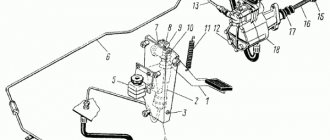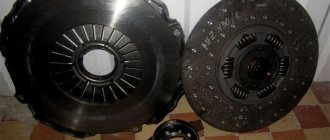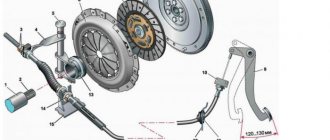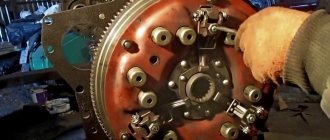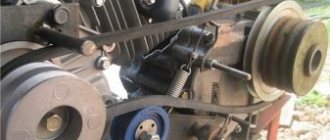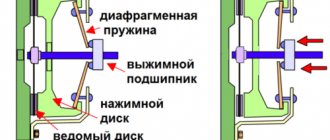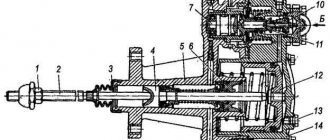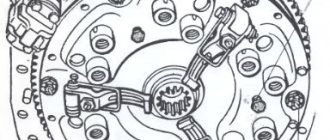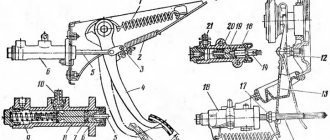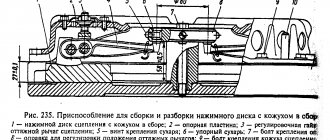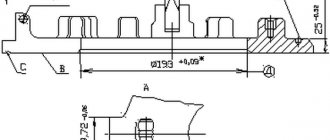- home
- Media center
- Articles
- Scheme of KAMAZ PGU
Menu
- News
- Articles
- Video materials
- Photo materials
- Publication in the media
- 3D tour
14.05.2019
A truck is a massive piece of equipment that requires a special approach. Driving a Kamaz is not easy; this Kamaz truck covers a lot of kilometers, so ease of control for the driver will play an important role.
In the design of modern cars, in the names of most mechanisms, a lot of abbreviations are used. PGU is one such name that is quite popular when it comes to trucks. The pneumohydraulic booster allows the Kamaz driver to operate the clutch pedal more easily, in other words, it makes it easier to press. Many will immediately find an analogy with power steering, and they will be right, because these components are components of one vehicle control system. Let's take a closer look at how this system works and what components it has.
The general structure of the CCGT system can be divided into several large visual parts.
- Piston pusher, adjusting nut. The system operates using high pressure, so pushing the piston is the basis of the entire working process. The adjusting nut holds the piston at a given position, so it is tightened when adjustments need to be made.
- Pneumatic and hydraulic pistons also perform pushing functions, interchanging each other’s work.
- The spring mechanism, gearbox, valve cover, and spring provide the necessary backlash, keeping the system stabilized at a given level.
- Diaphragm, control screw.
- Bypass valve, working piston. The bypass valve maintains the pressure at a constant level. Otherwise, this component is called “overflow”; accordingly, this name denotes the function of “transferring” pressure from one sector to another. The pressure difference creates the movement of air masses.
Together, these parts make up the internal “filling” of the PSU, but the spare part itself consists of only two main components: the front aluminum part and the rear cast iron part. Two different alloy parts are connected by a rubber gasket, which acts as a seal and a diaphragm at the same time. In addition to the gasket, soft plastic or rubber elements include special seals, cuffs, and small springs.
What kind of “beast” is this PSU
Let's start with the definition of the abbreviation "PGU" - this is a pneumohydraulic booster, an integral element of the clutch assembly. KAMAZ trucks are very large and massive, so they are not easy to drive. The driver of such a car would become a weightlifter pressing the clutch pedal if such a technological solution as a PSU did not exist. It makes life behind the wheel of a truck easier and more comfortable.
Simply put, it is responsible for reducing the applied force on the pedal. Although the pneumohydraulic booster itself is small in size, it performs a serious task - it facilitates the process of driving a heavy vehicle. Without it, changing gears would be a difficult process. All latest CCGT models consist of:
- tracking systems;
- executive pneumatic cylinder;
- indicator of the degree of wear of the linings on the driven disk.
The pressure of the liquid, which is located in the main cylinder of the device, is transported to the pneumohydraulic booster. This, in turn, forces the hydraulic pistons and servo system to work. When the pressure decreases, everything returns to its original position.
Node maintenance
For normal operation of the device, you must perform a number of actions:
- Fill the hydraulic system with high-quality brake fluid that meets the manufacturer's requirements. Poor quality fluid leads to failure of rubber seals;
- Install high-quality spare parts. The components must not be damaged. Cuffs and seals must be of high quality;
- Carry out regular visual inspections of the device. If leaks of working fluid occur, the amplifier should be repaired;
From the above it follows that the KamAZ 5320 PGU, the design of which is described above, is used on a car to reduce the force of impact when disengaging the clutch. The pneumohydraulic booster has a tracking effect, which allows you to regulate the supply of compressed air pressure from the driver’s cabin. For normal operation of the device, regular technical inspections must be carried out.
The specifics of truck transport require the complexity of controlling the mechanisms. Among other things, the driver sometimes has to make additional efforts to control the tractor. That is why designers have come up with many upgrades to reduce physical activity to a minimum.
Causes of CCGT failure
- If the PSU follower piston is jammed, this is due to swelling of the rubber ring or sealing lip.
- In the case when the compressed air in the pneumatic-hydraulic booster enters in small quantities or does not enter at all, the inlet valve of the CCGT unit will be “to blame”.
- When a “sinking” situation is observed in the operation of the pedal, this means that air has entered the hydraulic drive.
MAZ clutch PGU, device, diagram - manufactured by Spetsmash.
If there were no such overloads after installing (replacing) the amplifier, another version immediately arises - they slipped a defective one! And what, today everyone is counterfeiting, even some
or 238, even though the Brabus SV12 is assembled for the 600th gelding. Probably, only components for the Russian “Kalina” and the Ukrainian “Tavria” are not counterfeited - the material is more expensive.
If this distance is less than 50 mm, then this means that during operation the rod plunger will extend all the way, thereby opening the outlet of the liquid. All that is required is to move the lever one slot closer to the amplifier. If the distance is greater, then the reason for the leakage is different, and it is better to carry out a more detailed check at a car service center. However, we repeat, but most often there will be plenty of adjustment.
1 6430-1609205 Cylinder body 2 6430-1609324 Cuff 3 6430-1609310 Ring 4 6430-1609306 Washer 5 6430-1609321 Cuff 6 6430-1609304 Bushing 7 Ring 033-036- 19-2-2 Ring 033-036-19-2 -2 8 6430-1609325 Cuff 9 Ring 018-022-25-2-2 Ring 018-022-25-2-2 10 6430-1609214 Follower piston 11 Ring 025-029-25-2-2 Ring 025-029- 25-2-2 12 6430-1609224 Spring 13 Ring 027-03 0-19-2-2 Ring 027-03 0-19-2-2 14 6430-1609218 Seat 15 500-3515230-10 Clutch booster valve 16 842- 8524120 Spring 17 Ring 030-033-19-2-2 Ring 030-033-19-2-2 18 6430-1609233 Support 19 6430-1609202 Cylinder 20 373165 Pin M10x40 21 6430-1609203 G Ilsa 22 375458 Washer 8 OT 23 201458 Bolt М8-6gх25 24 6430-1609242 Spring 25 6430-1609322 Cuff 26 6430-1609207 Piston 27 6430-1609302 Ring 28 Ring 020-025-30-2-2 Ring 020-025-30-2-2 29 6430-1609236 Shaft 30 6430-1609517 Seal 31 6430-1609241 Rod 32 6430-1609237 Cover 33 6430-1609216 Cylinder plate 34 220050 Screw M4-6gx8 34 220050 Screw M4-6gx8 35 64221- 1602718 Protective cap 36 378941 Plug M14x1.5 37 101-1609114 Bypass valve 38 12-3501049 Valve cap 39 378942 Plug M16x1.5 40 6430-1609225 Breather 41 252002 Washer 4 42 252132 Washer 14 43 262541 Plug kg 1/8″ 43 262541 Plug kg 1/8″ 44 Ring 008-012-25-2 -2 Ring 008-012-25-2-2 45 6430-1609320 Tube 46 6430-1609323 Seal 46 6430-1609323 Seal Link to this page: https://www.kspecmash.ru/catalog.php?typeauto=2&mark= 11&model=293&group=54 www.kspecmash.ru
The first signs of problems with the pneumohydraulic booster
For beginners in the repair of KAMAZ CCGT units, it is sometimes difficult to recognize the first signals of a malfunction in the operation of the CCGT unit. But here is a small list of possible errors in clutch operation:
- When starting to move or when changing gear, the device responds late.
- The device responds only with significant amplification.
- Periodic “wedges” of the device.
If at least one of the above symptoms is present, then you urgently need to look for and troubleshoot the pneumatic-hydraulic booster unit.
Possible faults
The compressed air flow is insufficient to organize the work process, or is completely absent. It is the air mass under pressure that creates the operating torque of the mechanism. The cause of the malfunction is most likely a swelling of the intake valve, which cannot maintain the air flow at the proper pressure.
The follower piston is jammed. The reason lies in the deformation of the o-rings or cuffs. This problem can be solved by replacing soft components. Plastic or rubber parts of pneumohydraulics cannot be pulled out or repaired; they only need to be replaced.
The most obvious expression of a malfunctioning unit is the clutch pedal sinking. The main reason for “sinking” is air getting inside the hydraulics. It will definitely be difficult for a stuck pedal to go unnoticed, so this sign is considered the most obvious for drivers.
There are several other simple signs of a mechanism malfunction that the driver can evaluate and notice on his own.
- Before starting to move or switching gears, the device begins to operate with a delay. It is important to understand that gear shifting is an absolutely synchronous process that must be performed quickly and smoothly.
- Application of significant forces when switching. This problem eliminates the entire essence of the CCGT operation, which means the installation is clearly malfunctioning.
- The device jams periodically. This fact can also be classified as “out of sync”; the pedal may be pressed poorly (tightly or not fully).
There are several schemes for connecting a PSU: a standard scheme for the interaction of spare parts in the drive, the location of the fixing units, the location of the clutch pedal, the main cylinder and its cylindrical part, the follower mechanism, air pipes, the main hydraulic cylinder, coupling, rods, levers, hoses and tubes.
The PSU has a more than understandable structure, especially if the Kamaz driver is familiar with the general principles of the internal structure of the mechanisms of his vehicle. CCGT diagnostics are carried out approximately once a year, and the technical condition must be constantly monitored. Due to heavy loads, some parts of trucks fail earlier than planned by the next stage of maintenance. An experienced driver can repair a CCGT unit on his own; it is better for beginners to turn to specialists due to the large number of parts that they will have to deal with.
We begin the repair of KAMAZ CCGT units with our own hands
Having studied all the indicators of breakdown, have you decided to carry out the repair yourself? Then you need to start by disassembling the unit, the cycle of which is carried out strictly in the following order:
- The rear housing of the pneumatic booster is secured in a vice.
- The bolts and washers are unscrewed one by one.
- The air supply cover is removed.
- The valve is pulled out from the CCGT housing.
- The front housing assembly with the pneumatic piston is removed.
- The springs are removed from the membrane and pneumatic piston.
- The diaphragm is removed.
- The seal housing, thrust ring, follower piston and clutch release piston assembly are pulled out from the rear housing.
- The cap with the outlet seal and the bypass valve are unscrewed.
- The previously secured rear housing is released from the vice.
- The retaining ring is pulled out.
- The cones, washers and seat are removed from the valve stem.
- The sealing ring is removed from the follower piston body.
- The follower piston is removed and the remaining parts are removed from it.
- The O-ring and pneumatic piston are pulled out from the front housing.
- The cuff is removed from the pneumatic piston.
- All removed elements are cleaned in petroleum product: kerosene or gasoline, blown with compressed air and subjected to troubleshooting.
- After a high-quality inspection of the parts and repair of the required spare parts or their replacement, assembly is carried out in the reverse order.
How can you adjust a KAMAZ CCGT unit?
The final stage of device restoration is the adjustment of the KAMAZ PGU. To do this, it is necessary to ensure a full stroke of the pneumatic amplifier pusher of at least 25 mm . Because when the indicator is low, the clutch is completely disengaged. Thus, the full stroke of the pusher is tested by pressing the clutch pedal as hard as it will go.
If the stroke is not at the proper level, then the fluid level in the reservoir of the clutch master cylinder and the free stroke are re-tested. If a need is detected, air is removed from the hydraulic system. In order for the CCGT to serve efficiently and reliably, it is important not to forget about its timely repair and maintenance.
The pneumatic power steering on KamAZ is an important mechanism of the clutch system, which is designed to reduce the load on the pedal exerted by the driver of the vehicle. How to bleed the PGU on a KamAZ to restore the functionality of the clutch system? This device must be pumped from time to time, including when adjusting the clutch. The unit is subjected to serious pressure, therefore, problems often arise with it - for example, extraneous noise or crackling, slipping, etc.
KAMAZ clutch basket
The KAMAZ clutch basket is an element of the clutch transmission kit for trucks, tractors and special equipment on the chassis of the Kama Automobile Plant. Heavy commercial equipment is used and maintained by professionals. We will not talk about the design and principles of operation of a pressure-type drive disk with a diaphragm spring with a casing assembly of a truck and German original Sachs clutches. Moreover, as you can see, they wrote about this separately. We will lay out only the basis that will allow:
- Learn in detail about KAMAZ clutch baskets;
- Master the applicability of models;
- Choose the right car part;
- Buy an original or a high-quality analogue at the lowest price.
Parameters and dimensions (diameter) of KAMAZ clutch baskets
KAMAZ vehicles mainly use diaphragm pressure plates with the following parameters:
- MFZ430 – 430mm;
- MF395 – 395mm;
- MF362 – 362mm.
Main catalog numbers of baskets Sachs (Germany) for KAMAZ Euro
Baskets – analogues of E.Sassone (Italy)
Analogs by Donmez (Hammer Kupplungen)
The principle of selecting a clutch basket for a specific KAMAZ model
To select the right Sachs basket or an analogue, you need to know the KAMAZ model, as well as the engine and gearbox. You can do this yourself using the catalogs of GAS Quatro LLC:
- General applicability of imported clutches on domestic commercial vehicles;
- Specialized applicability of Sachs clutches to KAMAZ.
Despite the apparent ease of selection, everything is not so simple. Let's take, for example, baskets of the same type and diameter: 3482083219 and 3482083118. Despite all their similarities, the first one is equipped with more powerful Cummins engines than the second one. Incorrect selection and installation of the clutch basket will cause rapid failure of the driven disc and bearing, and possibly the flywheel.
What kind of mechanism is this
PGU is a pneumatic type hydraulic amplifier. This device consists of the following structural elements:
- piston;
- piston pusher;
- two valves - inlet and bypass;
- fuel fluid intake systems;
- complex seal;
- traffic jams;
- air compression systems;
- a protective cover that prevents the risk of damage to the amplifier structure;
- spherical nut and locknut;
- spring mechanism;
- diaphragms;
- gearbox
The pneumatic hydraulic booster must be pumped from time to time. This allows the clutch system to work as it should. The level of safety increases, because when you press the appropriate pedal, there is no subsidence or slippage - very dangerous phenomena.
Pumping of the CCGT unit is relevant for any models and modifications of KamAZ, for example, 43114, 5511, 53501, 65117, 6520, 43118, 55111, etc.
Amplifiers used on KamAZ
Structurally, KamAZ vehicles provide for the use of products of both domestic and foreign production. The operating principle of the mechanisms is identical; the devices differ in characteristics and design.
- Thus, the 5320 amplifier, produced at the Kama plant, structurally uses a vertical arrangement of the follower mechanism; the pneumatic cylinder is also installed vertically. Such devices are used on modifications: 5320, 4310, 43118, etc.
- The WABCO amplifier is manufactured in the United States of America. The product is distinguished by its compact size and lining wear indicators, which facilitates the use of the PGU. Similar devices are used on new KamAZ vehicle models: 5460, 6450, 6460, 65117, etc. The amplifier is compatible with “154” series gearboxes, which are used with power units that meet Euro-2 and Euro-3 standards.
- PGU "WABCO" for KamAZ modifications: 6460, 6520 and other equipment with ZF gearboxes.
- PGU "WABCO" for modifications of KamAZ: 4308, on which a ZF five-speed gearbox is installed.
- CCGT units made according to the “WABCO” type are produced in Ukraine and Turkey.
PSU for KamAZ 5320:
How an amplifier works
The essence of the PSU action is that this mechanism disables the clutch system, thus neutralizing the impact of significant pressure on it from the driver. When a person presses the corresponding pedal, the fuel fluid begins to press on the piston system of the amplifier. The piston moves down, causing the intake valve to open. An air flow rushes into the opened hole under pressure, which reaches the pneumatic piston pusher. This pusher retracts the fork, causing the clutch to deactivate.
Inspection and testing work
Initially, it is necessary to determine whether the clutch needs to be adjusted and bled. This can be determined by the presence or absence of air leakage. The stronger the leak, the worse the pneumatic hydraulic booster works.
You can check by simply pressing the pedal (the engine must be turned off). If the driver hears a characteristic whistle, this indicates a strong leak. If you cannot detect it by sound, you can apply a soap solution. The appearance of bubbles will indicate a malfunction of the clutch system.
Before pumping the clutch on a KamAZ, the PSU device must be tightened with fastening bolts. It is also advisable to make sure that there is enough liquid in the tank to meet the needs of the system. Also check that the springs that control the movement of the corresponding clutch mechanisms are not stretched.
Production
The KamAZ-5320 PGU device is suitable for many model modifications of this manufacturer. Most old and new tractors, dump trucks, and military variants are equipped with pneumatic-hydraulic power steering. Modern modifications produced by various companies have the following designations:
- Spare parts for KamAZ (PGU) manufactured by KamAZ OJSC (catalog number 5320) with vertical placement of the tracking device. The device above the cylinder body is used on variations under the index 4310, 5320, 4318 and some others.
- WABCO. CCGT units under this brand are manufactured in the USA and are distinguished by their reliability and compact dimensions. This equipment is equipped with a system for monitoring the condition of the linings, the level of wear of which can be determined without dismantling the power unit. Most trucks with a 154 series transmission are equipped with this type of air-hydraulic equipment.
- Pneumatic hydraulic clutch booster "VABKO" for models with ZF type gearbox.
- Analogues produced at a plant in Ukraine (Volchansk) or Turkey (Yumak).
Adjusting the pedal free play
Ideally, its free play is no more than 1.5 cm. You can check it this way: a regular ruler rests on the floor under the pedal, after which they gently press the pedal, measuring how much it has moved freely, that is, without touching the piston.
If the indicator exceeds the established norm, it means that there is a gap between the mechanisms that should not exist. It’s easy to fix, using model 65115 as an example:
- the pedal should be in the highest position, there is no need to press it;
- the castle nut is loosened to allow movement of the eccentric pin;
- the eccentric pin is carefully rotated, as a result of which the existing gap is reduced;
- set the gap within 0.6-1.5 cm, then tighten the nut back.
As for the stroke of the pedal itself, it should not exceed 20 cm and not be less than 18 cm. The problem, if any, can be corrected by adjusting the movable stop, which is located at the top of the pedal.
Adjusting clutch free play
Further pumping of the clutch on a KamAZ 65115 vehicle involves carrying out adjustment work regarding the release clutch. The part is installed to disengage the clutch. The amount of free play should be within 3-4 mm. This indicator will correspond to a similar indicator of the fork stroke - it is approximately 4-5 mm. Changing these numbers requires immediate adjustment.
- the fork, which deactivates the clutch, is moved to the side, and the spring mechanism is removed;
- the lever stroke is checked manually;
- restoration of the normal motion of the coupling is carried out by adjusting the shaft with a spherical nut, which is part of the pneumatic pusher;
- when the required value is reached, the spring is installed in place.
Article: 11.1602410-40, additional articles: (PGU) 11.1602410-40
Order code: 028656
- Buy with this product
- show more
The purpose of the PSU is to reduce the effort exerted by the driver on the clutch control pedal in order to meet the ergonomic requirements for the driver’s workplace of the vehicle. The CCGT can be installed on vehicles with a source of compressed air with a working pressure of 0.65:0.8 MPa (6.5:8 kgf/cm2)
Modification 11.1602410-40 is intended for direct flange mounting to the bracket or clutch housing of KamAZ engines with diaphragm clutch type “154”, “152”.
On cars, depending on the models and trim levels, the following clutch is used:
Pneumohydraulic booster: 1 — lining wear indicator; 2 — washer; 3 - body
— friction, dry, double-disc, with peripheral springs, model 142;
— single-disk, diaphragm, exhaust type models MFZ 350, MFZ 430 f. “SACHS” (Germany) (see Fig. Clutch of models MFZ 350. MFZ 430):
— friction, diaphragm, single-disk, push-type model MF-395 f. "SACHS" (Germany) (see Fig. Clutch model MF-395).
The clutch control drive is hydraulic, equipped with a pneumatic hydraulic booster (PGU), the clutch of models MFZ 430, MFZ 350, MF 395 is PGU (Germany).
Brief technical characteristics of the clutch
Transmitted torque, N.m (kgf.m)
Number of compression springs
Force of springs and diaphragm during clutch, kN (kgf):
At PGU f. “WABCO” has installed lining wear indicator 1 (see Fig. Pneumohydraulic booster). Complete wear of the clutch driven disc linings is indicated by the distance between the plastic housing 3 and washer 2, which, as the linings wear out, becomes equal to 23.25 mm. With new linings, washer 2 should rest against body 3.
Clutch models MFZ430, MFZ350: 1 - gearbox input shaft; 2 — driven disk hub; 3 — driven disk; 4 — pressure disk; 5 - diaphragm; 6 — clutch release clutch.
Clutch model MF-395: 1 — gearbox input shaft; 2 — drive disk hub; 3 — driven disk; 4 — pressure disk; 5 - diaphragm; 6 — clutch; 7 — pneumohydraulic booster
Determine the free play of the clutch release clutch by moving the lever by hand (see Fig. Free play of the clutch release clutch). Disconnect the spring. The normal clutch stroke corresponds to a lever stroke of 45 mm. If the lever stroke is less than 3 mm, then adjust the lever stroke by rotating the spherical nut.
Adjusting the full stroke of the piston pusher
The optimal indicator of the amplitude of movement of the piston pusher for 5320 EURO is at least 2.5 cm. If it is smaller, it will not be possible to achieve high-quality clutch release. Because of this, characteristic problems arise when working with this system, as well as the gearbox.
You can check whether the movement of this mechanism corresponds to the norm by pressing the pedal all the way. If it is insufficient, then you need to check the fluid level in the tank, and also adjust the free play again. The final stage is the actual pumping. You can also read about the KamAZ speed sensor - Where is it located and the connection diagram.
Kamaz Cummins engine fault codes
Modern KAMAZ truck models are equipped with Cummins engines. Power plants are reliable and durable. Standard Cummins errors and trouble codes can be read in several ways. Improper operation and care can greatly damage the motor, which will lead to its rapid wear.
Decoding error codes for Kamaz with Cummins engine
Typically, drivers use 2 procedures to read fault codes.
- Self-diagnosis. Here a special lamp lights up on the dashboard and errors are read using a flash code. The procedure does not require any additional equipment. Reading faults is problematic. The flickering of the indicator is often misunderstood, which introduces a lot of erroneous data.
- Connecting a third-party programmer. An external computer makes more accurate diagnostics and displays codes on the display, which allows you to accurately determine the cause of the breakdown and eliminate it. The problem here is the inaccessibility of modules for some drivers.
Kamaz 43255, 53605, 65117,4308 with Cummins Euro 4 and 5
The car models listed above are equipped with a power plant with a single software. Electronic units supplied to assembly lines have similar encryption and similar error codes.
Kamaz 43253 with Cummins: what is the error SPN 4336 Fmi 7
Low level of urea detected in the system - replenish the fluid level.
SA 11 - Kamaz Cummins error
The problem is in the ABS system. The rear left wheel rotation sensor may be damaged. The malfunction may also occur due to severe contamination of the sensor itself.
SPN 611 FMI 14 Cummins - error
The next defect is in the Kamaz ABS system. An inversion of the bridge speed sensors is observed. It is necessary to check the sensor lines for oxidation and damage.
